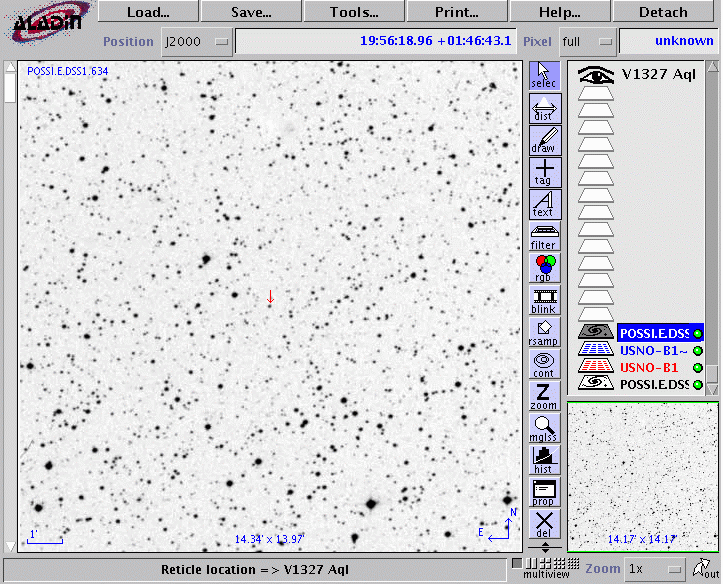
On the night of Aug 02/03, 2005 EDT, I used the RIT Observatory's 12-inch Meade telescope and SBIG ST8 CCD camera to investigate possible targets for the near future. The Center for Backyard Astrophysics declared that our previous target, MV Lyr, had been observed enough; they suggested several new targets:
I decided to use several hours on a night of mediocre weather to figure out which of these would be best for our equipment.
The plan:
Notes from the night
For each of the targets, I took a short series of 120-second unfiltered images. Flatfields from previous runs didn't look similar to tonight's background pattern, so I performed no flatfielding on the images. You'll see a clear pattern in the images -- more light near the center, less near the edges and corners. For tonight's investigation, that's not very important.
Rod Stubbings announced recently that this little-known dwarf nova was in outburst, so it might become an interesting target.
This is a chart of the field made with the Aladin tool. The field is about 14x14 arcminutes, which is just a bit smaller than the field of our ST-8 CCD mounted on the 12-inch telescope.

Below is a median of 3 images taken at the start of the night. The variable is at the center of the blue circle.
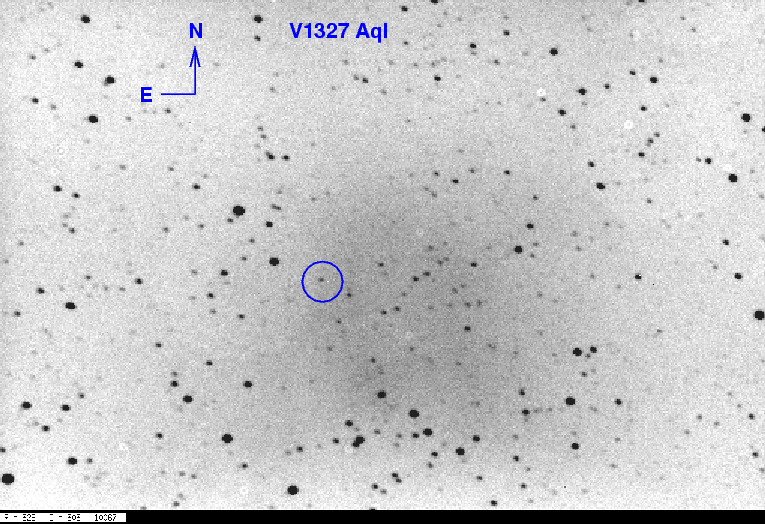
The star appears only slightly brighter than its image on the POSS I plate shown in the finding chart. Using USNO B1.0 stars in the field, and assuming that my unfiltered images are approximately equal to the V passband, I estimate V1327 Aql to have the rough magnitude 16.7 that Rod Stubbings quoted.
Looks too faint for us.
The star IX Dra is another dwarf nova. Joe Patterson wrote about it (and its neighbor MN Dra) in June, 2005:
3. IX Dra and MN Dra. These are two dwarf novae with very small superhump period excesses (Psh-Porb) reported. The data seemed kinda uncertain in both cases, but this is an important question to be really sure of! In fact, both of these are overall mystery stars with nearly everything up in the air - the recurrence time, the eruption shapes, the values of Psh and Porb, the amount of time spent at max and min, etc. I especially recommend IX Dra for now, though the observing seasons are long. These are stars for which even *snapshot* magntiudes are useful - though of course our main nutrient is long time series.
This is a chart of the field made with the Aladin tool.
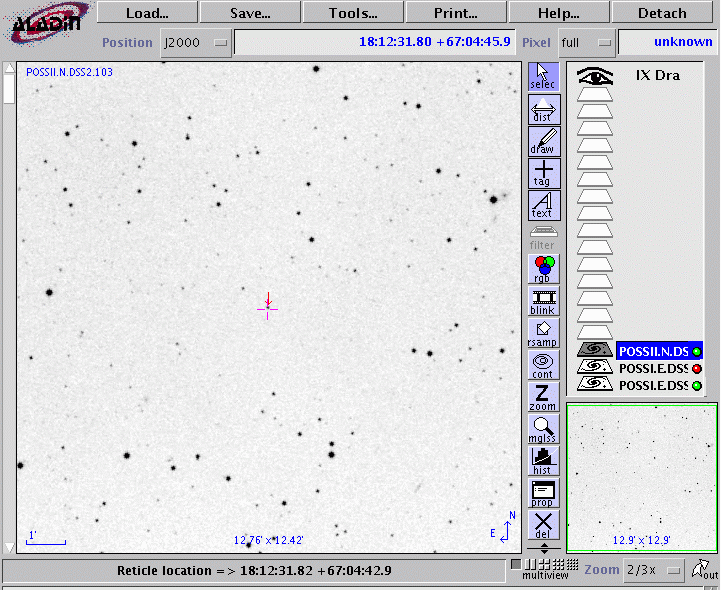
Below is a median of 4 images. The variable is at the center of the blue circle.
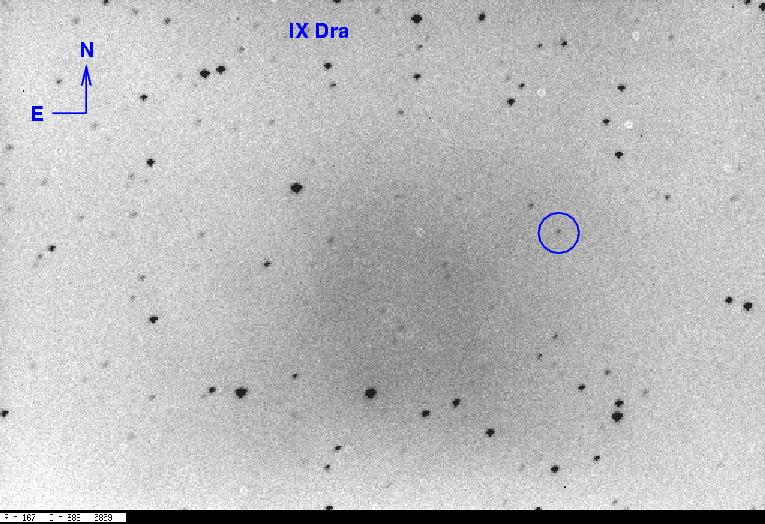
The star appears unchanged from its brightness on the POSS I plate shown in the finding chart. Using USNO B1.0 stars in the field, and assuming that my unfiltered images are approximately equal to the V passband, I estimate IX Dra to have a rough magnitude of V = 17.4 or so.
Again, too faint for us.
The star MN Dra is another dwarf nova. See the notes for IX Dra, above, for a bit of information about it.
This is a chart of the field made with the Aladin tool.

Below is a median of 16 images. The variable isn't really visible: its position is marked by the two short blue lines. There is a VERY faint smudge at the variable's position, but just barely above the noise.

From what I can see, the star seems fainter than its appearance on the POSS I plate shown in the finding chart. Using USNO B1.0 stars in the field, and assuming that my unfiltered images are approximately equal to the V passband, I estimate MN Dra to have a rough magnitude of V > 18, but that's really, really rough.
This is WAY too faint for us.
Joe Patterson's most recent message to the CBA observers had this to say about HS 1813+6122
And a new Draco entrant: HS1813+61 ("Dra"), reputed to be at Po-0.148 d although really with very little known about it.
Jochen Pietz has observed this star as part of a project to followup CVs noticed as part of the Hamburg Quasar Survey (some of the QSO candidates turn out to be variable stars). Jochen writes briefly:
CV is varying with the orbital period [of 203 minutes] (as described at http://quetzel.warwick.ac.uk/phsdaj/HQS_Public/HQS_Public.html) and an amplitude around 0.25mag. No large-scale brightness variations found in these observations.
This is a chart of the field made with the Aladin tool.
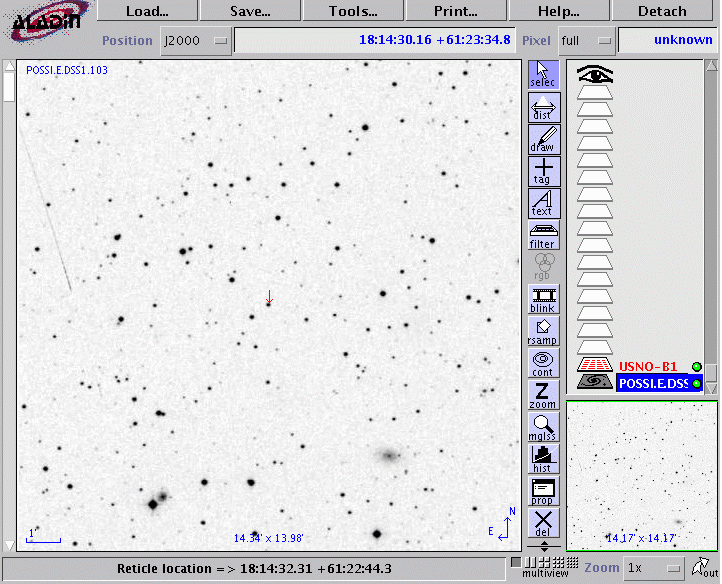
Below is a median of 11 images. The variable is at the center of the blue circle.
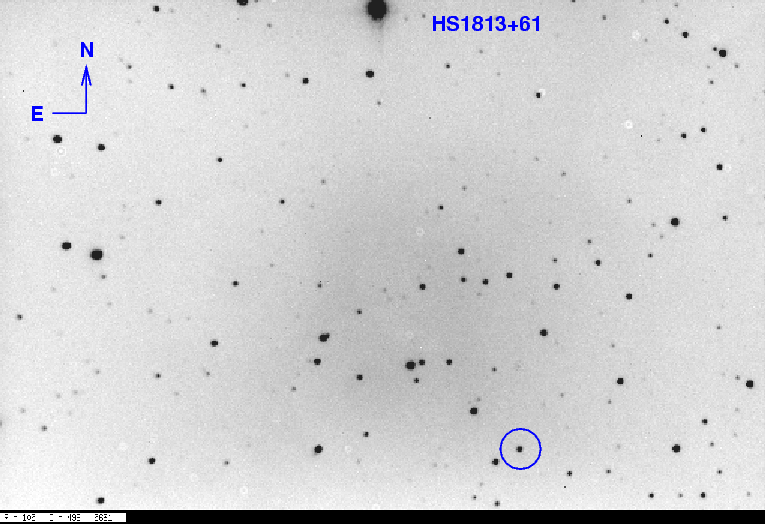
Finally! This star provides enough signal for us to get a decent measurement in a 2-minute unfiltered exposure. I did a quick-and-dirty photometric analysis -- without flatfielding, remember -- to get an idea for the scatter we might expect in measurements of this star. An ensemble of 11 images shows "scatter-vs-mag" like so:
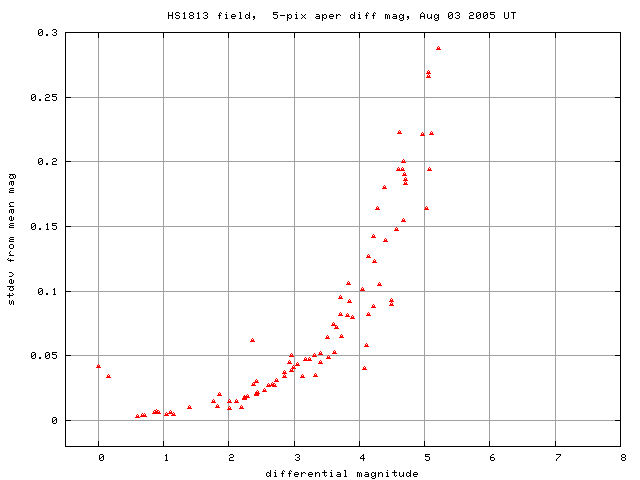
The two brightest stars have elevated scatter because they are slightly saturated, I think. Otherwise, the brightest un-saturated stars in the ensemble show a nice floor of less than 0.010 magnitude RMS. The position of HS 1813+61 is around differential magnitude 2.5 on this scale; the scatter there should be around 0.02 mag, which is small enough to make it a good target.
This is the one we'll pick for future work.
Last modified 8/3/2005 by MWR.